Follow the Tributaries of the Loire on a Delightful Slow Vacation
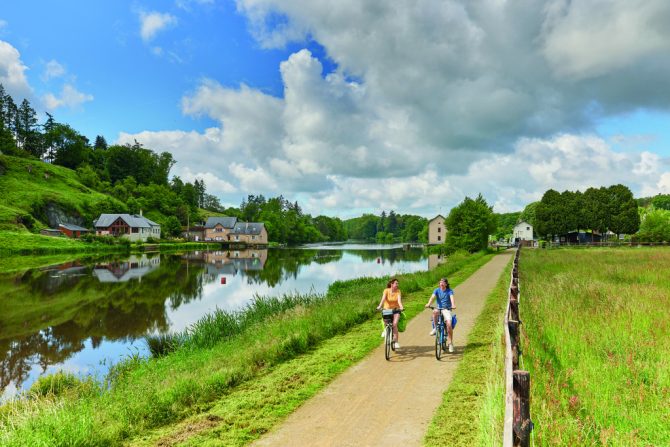
A new slow tourism initiative follows the tributaries of the Loire and knits together active travel, artisan workshops and long riverside lunches
I’m sitting in the early June sunshine, listening to the hushed cascade of the river as it flows over a wide, shallow weir. Like the patient heron beneath the old mill across the river, I’m relaxed about my own forthcoming lunch, being prepared at L’Écluserie in Origne – a former lockkeepers’ cottage that’s been transformed into a guingette (riverside bar). On the river bend, a stately manoir perches above the river’s forested banks.
The river is the Mayenne, which, along with the Oudon, Sarthe and Maine, makes up part of France’s largest navigable river basin. A new eco-tourism initiative, entitled Tourisme Fluvestre, aims to highlight the many river-based and terrestrial activities in the area: visit the newly-launched website west-rivers.com to explore the eclectic range of activities and destinations available, before charting a course along the tranquil, forested waterways.
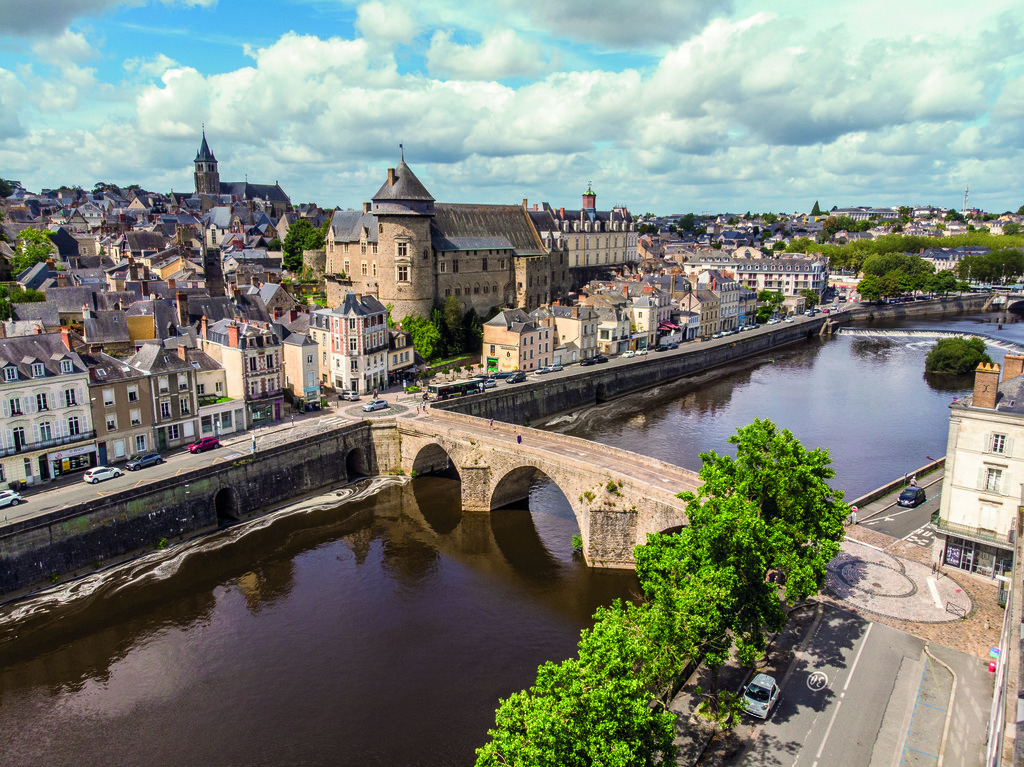
Laval © shutterstock
We’ve already finished one leg of our adventure by travelling on e-bikes along the Mayenne from our first stop, Laval – an attractive small city with a riverside castle, a pretty reminder of its medieval heyday. Behind the castle, its historic centre is a knot of peach-hued cobbles, half-timbered houses and good places to eat and drink (a refreshing strawberry, basil and lime weissbier from bijou brewery Temple Mousse is a hot-summer-day essential). Meanwhile, the castle has become a museum dedicated to the Naïve artists of the 19th century, a movement led by local boy Henri Rousseau.
We take a spin on the river in the new-looking white speedboats available to rent in Laval (among other places along the rivers). These lightweight electric vessels, their speed topping out at 3mph, are just large enough for a group of friends and a well-stocked picnic basket. Hopefully, they’re also quiet enough not to draw the attention of the occasional seven-foot catfish that apparently migrate up from the Danube to these parts.
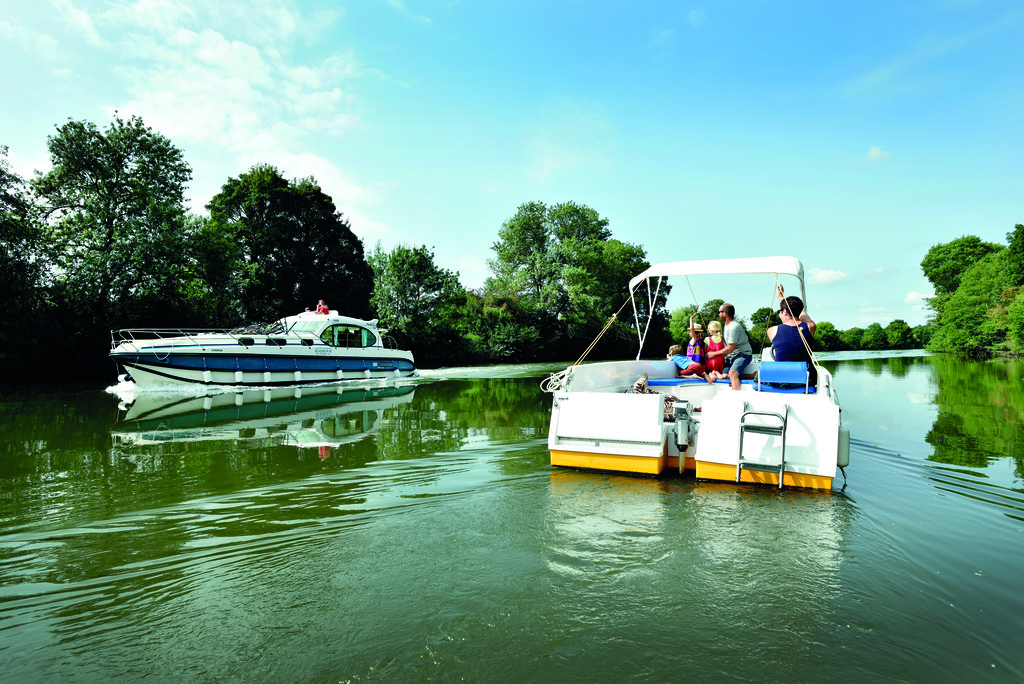
Little speedboats are perfect for a day out on the water with friends © PAscal Beltrami / Sarthe Tourisme
Electric eclectic
When lunch arrives at my tranquil manoir-view table at L’Écluserie in Origne, I hardly feel like I’ve earned it. Laval’s sandy towpath is spacious, flat and uncrowded (the battery is somewhat unnecessary), the river a steady companion on one side and a hinterland of unruly oaks and ruby red foxgloves on the other. My route is part of one of three national cycle trails that crisscross the Mayenne department, while our lunch stop is one of 37 lockhouses in this department alone. Most have been converted into B&Bs, artisan workshops and guinguettes.
This being France, these homey lock-side stops offer superb cuisine at often pinch-me prices. At L’Écluserie, my group and I devour a sticky Chinese-influenced pork and noodle feast that, in the end, is simply too generous for us to finish. Somehow, room is found for a summery slice of rhubarb-studded gâteau aux fruits, and all of it for €14 per person.
The following day, after a peaceful two-hour kayak along the river (passing only a single boat), we stop for lunch in the charming riverside town of Grez-Neuville. The three-course lunch at L’Écluse (The Lock) is several grades above L’Écluserie and still only costs €21.50. Obviously, despite the outdoorsy, active-travel philosophy of this river-based adventure, nobody is going home any slimmer. And while the quality and value of these riverside establishments offer a wonderful continuity as we travel south along the river to Angers our final destination the activities that line the riverside are surprisingly eclectic.
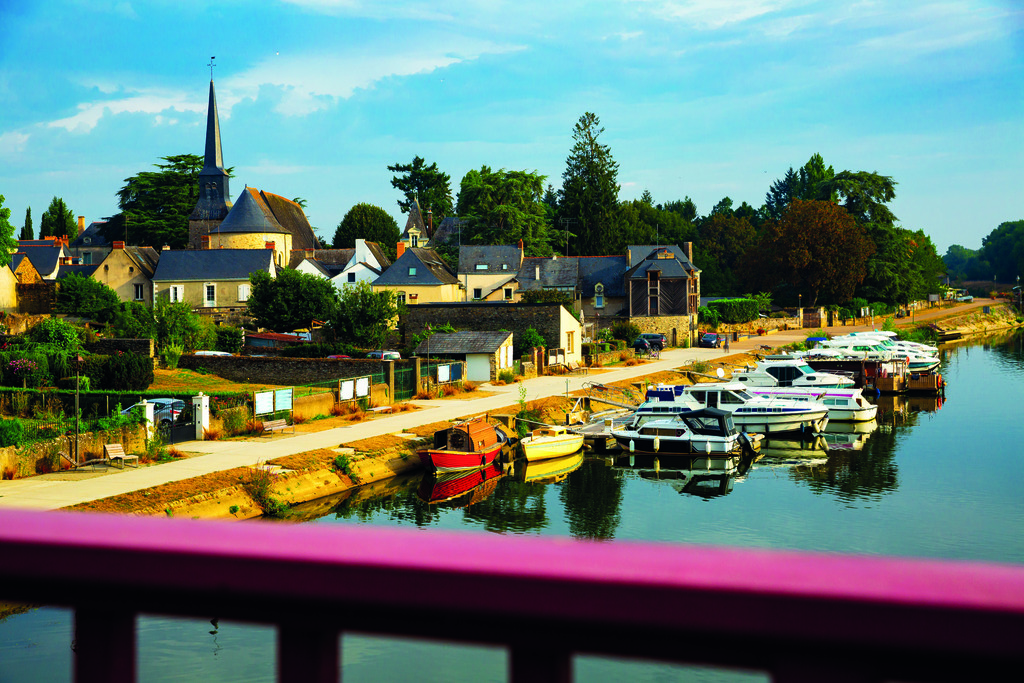
Grez-Neuville © shutterstock
This is exemplified at our next stop, Neuville Lock – a riverside hamlet set in a picturesque spot on the Mayenne river. At this lock-keepers’ cottage there is a knife-making workshop called the Coutellerie du Maine-Anjou, the baguettes and beer fridges having been swapped out in favour of display cases and industrial sanders.
We’re welcomed by cheerful, bearded Antoine who set up this miraculous use of space in 2018, somehow squeezing a small shop, office, workshop area and several heavy-duty industrial sanders into a building the size of a small local post office. He explains how knife-making has a long history in the Anjou region. Tapping into this heritage with an hour-long knife-making session (€120pp), we discover, is an absorbing undertaking. After choosing from pear wood, walnut or ash handles, we painstakingly whittle away until we’ve shaped (and laser monogrammed) an elegant and unique souvenir to take (or better yet mail) home.
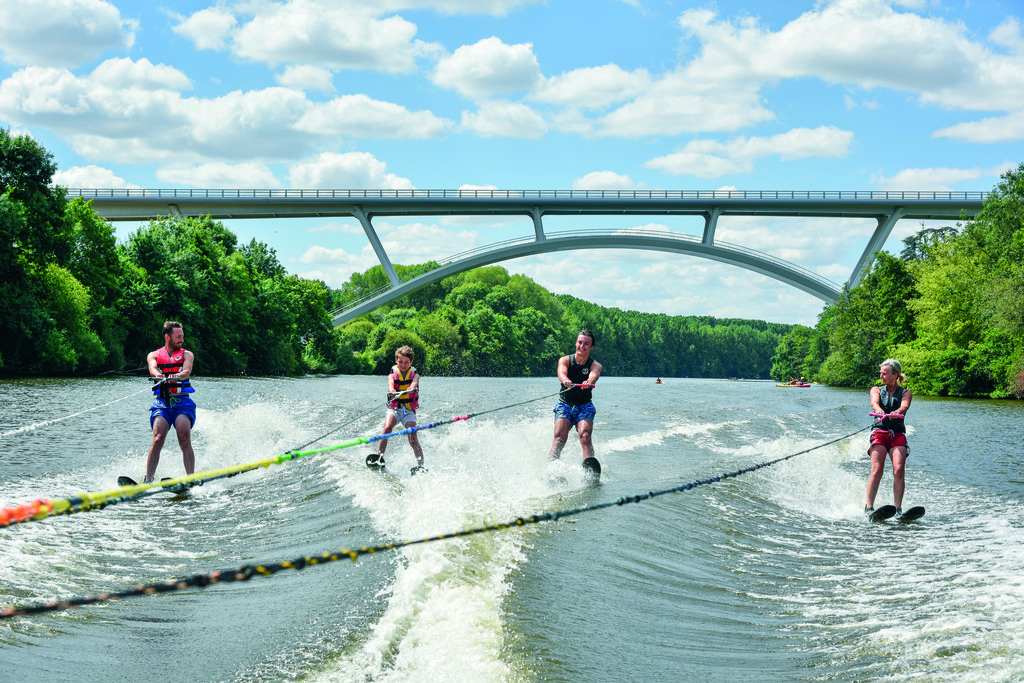
© Mayenne Tourisme
From old traditions to new at the town of Château-Gontier, a charming place that, we notice upon entry, is proudly twinned with Frome in Somerset (a regular winner of quality-of-life awards in the UK). There’s clearly good living in Château-Gontier as well. The town has official recognition for its abundant flower displays and the mellow summer evening is characterised by buttery jasmine breezes and the murmur of outdoor drinkers at cosy bars like Le Havane.
Château-Gontier’s good vibes are embodied by Chris, who we meet by the riverside. Owner of Canotika, a kayaking and canoeing club, his passion for all water-based sports is evident and infectious. Child-like joy emanates from his face as he shows us the wrecked motorboats that he’s painstakingly converted to pedal power. And then there are the miniboats. Locally built, these are electric versions of Italian Riva speedboats, roughly the size of a large wheelie bin. The few available to rent at Canotika represent the majority in existence today. “A canoe with an engine,” Chris manages in his halting English. Soon we’re speeding around the stretch of river nearby, huge smiles plastered on our faces. Rock music drifting across the water from a nearby guingette just adds to the fun.

© Teddy Verneuil / Lezbroz
The good life
The Mayenne eventually wends its way into our final stop at Angers. The capital of Anjou, Angers regularly rates as one of the cities with the best quality of life in France. Whether this is due to the 100m² of green space per citizen (double the national average) or because Angers’ Le James Joyce Irish pub, as a local assures us, is the regional leader for annual pints pulled, is a matter for the social scientists. Angers’ city centre is an engaging mix of styles, with eye-catching Belle Epoque mosaics and Art Nouveau flourishes ornamenting the architecture. The pavements are marked with a sky-blue line that leads the curious traveller through the city’s best bits.
There’s slate everywhere; the local, historically important quarries closed more than a decade ago. Slotted on roofs and into walls, it’s often blooming with rusty patches from iron pyrite deposits. An immense Plantagenet Gothic cathedral squats amid it all, and beneath its nave lie the remains of queen consort Margaret of Anjou. Displayed outside are plans for a modern Kengo Kuma-designed gallery soon to be added to the cathedral’s front.
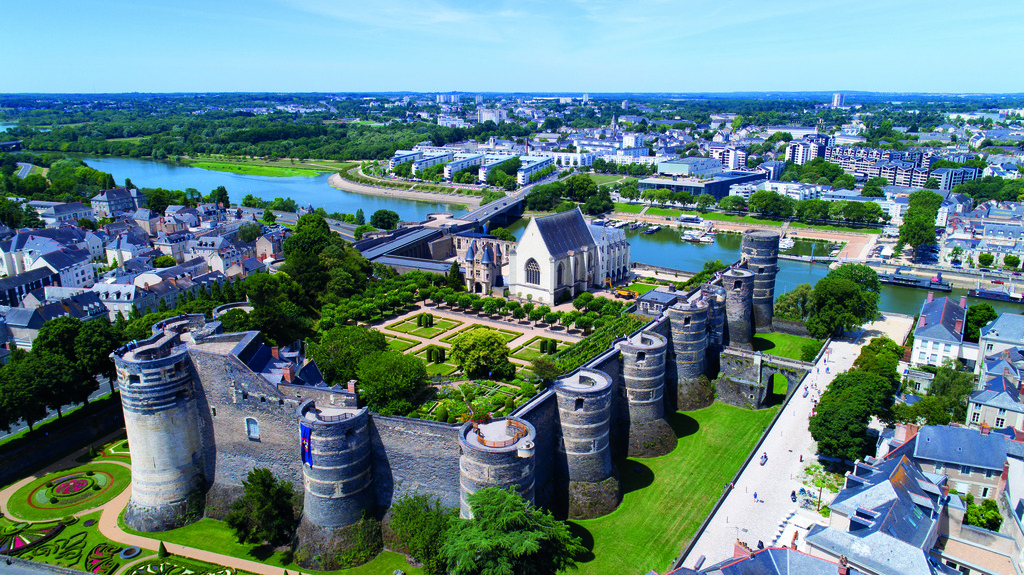
Angers castle © shutterstock
But everything in the city, even the cathedral, resides in the shadow of the 9th-century Château d’Angers. Encircled by 17 pale sandstone towers, darkly striped with slate, this fortress is truly awe-inspiring. Once the seat of the dukes of Anjou (an honorific now claimed by the local, highly successful ice hockey team), it’s little surprise to learn that the castle has never been taken by force. Now beautifully restored – it’s even got its own boutique vineyard on the ramparts – the castle is also home to the UNESCO-listed Apocalypse Tapestry.
The 14th-century tapestry is six metres tall and runs for 140 metres around a low-lit gallery that takes some adjusting to after the bright sunshine. Super-sized medieval looms were built to produce what was, in effect, an enormous anti-English propaganda leaflet, created at the behest of Louis I, Duke of Anjou. Give yourself time to rest on the benches and slowly absorb the extraordinary detail of the narrative imagery.
When we emerge blinking from the gallery, we gather at an arch for a group photo. From beneath the arch, part of the original 9th-century part of the castle, it’s possible to see leafy Angers laid out below, the river snaking through. Close by, the Mayenne splits off into the Sarthe leading to Le Mans and the Maine, the smallest river in France, which takes you to the Loire. A watery junction splitting off to further adventures, destinations and, of course, long lunches.
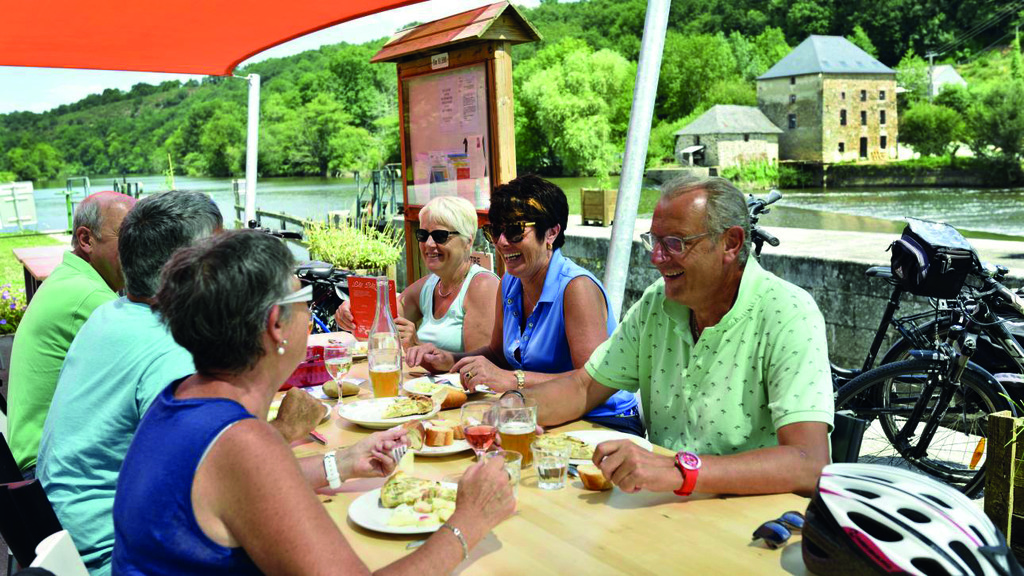
© Pascal Beltrami
PAYS DE LA LOIRE ESSENTIALS
GETTING THERE
BY PLANE
- Fly with easyJet or Ryanair to Nantes from London, Bournemouth or Manchester. After you land following a flight of about an hour, hop on a 45-minute train to Angers.
BY TRAIN
- Travel by Eurostar from St. Pancras to Paris (approx. three hours) before changing to a TGV train for a 1h 45m connection to Angers.
BY CAR
- Board a ferry or travel via the Eurotunnel before driving cross country to Angers. With favourable traffic, this method should take close to eight hours in total.
WHERE TO STAY
- Parc Hôtel, Château-Gontier: This spa hotel inhabits a 19th-century mansion with lovely, leafy grounds that feel miles away from nearby central Château-Gontier Spacious rooms in the main building (doubles from €94) balance the history of the house with well-judged modern touches. There’s also a tennis court, pool and warm welcome from owner Anne-Laure with apéros served on the lawn.
WHERE TO EAT
- L’Écluse, Grez-Neuville: On the canalside and enclosed by lavender, this outstanding restaurant (named after the nearby lock) offers seasonal three-course lunches for around £20.
- L’Esprit Cuisine, Laval: This stylish restaurant offers a short chalkboard menu offering excellent value food that’s full of flavour. Despite the deconstructed onion soup and other innovations, the mood is relaxed, the service warm.
- Carmine, Angers: Housed in a chalet-style building, this hip riverside newcomer is popular with seemingly all of Angers’ demographics. The vibe is casual, while the menu, featuring hearty dishes such as confit beef with hazelnut mash, are on point.
TOURISM CONTACTS
- west-rivers.com
- atlantic-loire-valley.com
- mayenne-tourisme.com/en
- anjou-tourisme.com/fr
- tourisme.destination-angers.com/en
From France Today Magazine
Share to: Facebook Twitter LinkedIn Email
More in canoeing in France, cycling, Loire River, loire valley, riverside, slow travel
By Chris Allsop
Leave a reply
Your email address will not be published. Required fields are marked *



